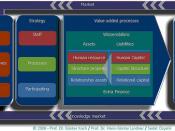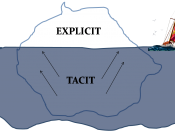The organizational tension refers to the difficulty in achieving a balance between process and practice. Process refers to a top-down structured coordination of people and information whereas practice refers to a more bottom up approach which subscribes to the notion that the best way to foster knowledge is by responding to the creative ways in which people get things done. In the absence of practice rigid structure exists leaving little room for improvisation and in the absence of process creativity runs rampant in the without a structure to harness it.
This tension is something managers live with because the only solution lies in turning the tension to their advantage by striking a balance since the problem cannot be worked around. In contrast to the process model, which assumes predictability, the practice model assumes unpredictable conditions under which people do their jobs. The other issue is to facilitate shared expertise, which is a challenge as only the high-level employees are allowed to be inventive whereas others are confined to routine bound jobs.
Measures to foster mindfulness involve improvisations to make up for the difference between the conditions people's job routines were designed for and actual conditions that come with the territory of a steadfast world. The challenge for managers is analogous to maintaining two different images in the same view simultaneously.
Identifying the knowledge isn't a bed of roses because of the chasm that exists between what is documented in a process manual and the necessary subtle improvisations used in implementing the task in reality. By employing mindfulness and paying attention to significant details, managers can take measures to learn where the local knowledge is, assess the value of the knowledge, notice errors and increase the shared expertise and freedom to use the knowledge.
Repair technicians at Xerox knew different...


